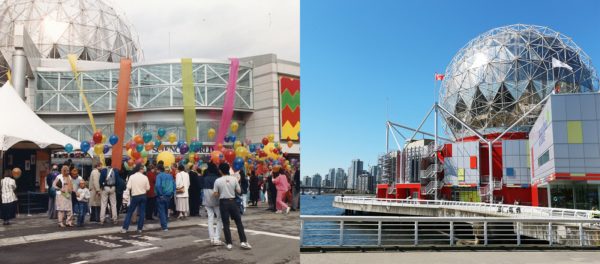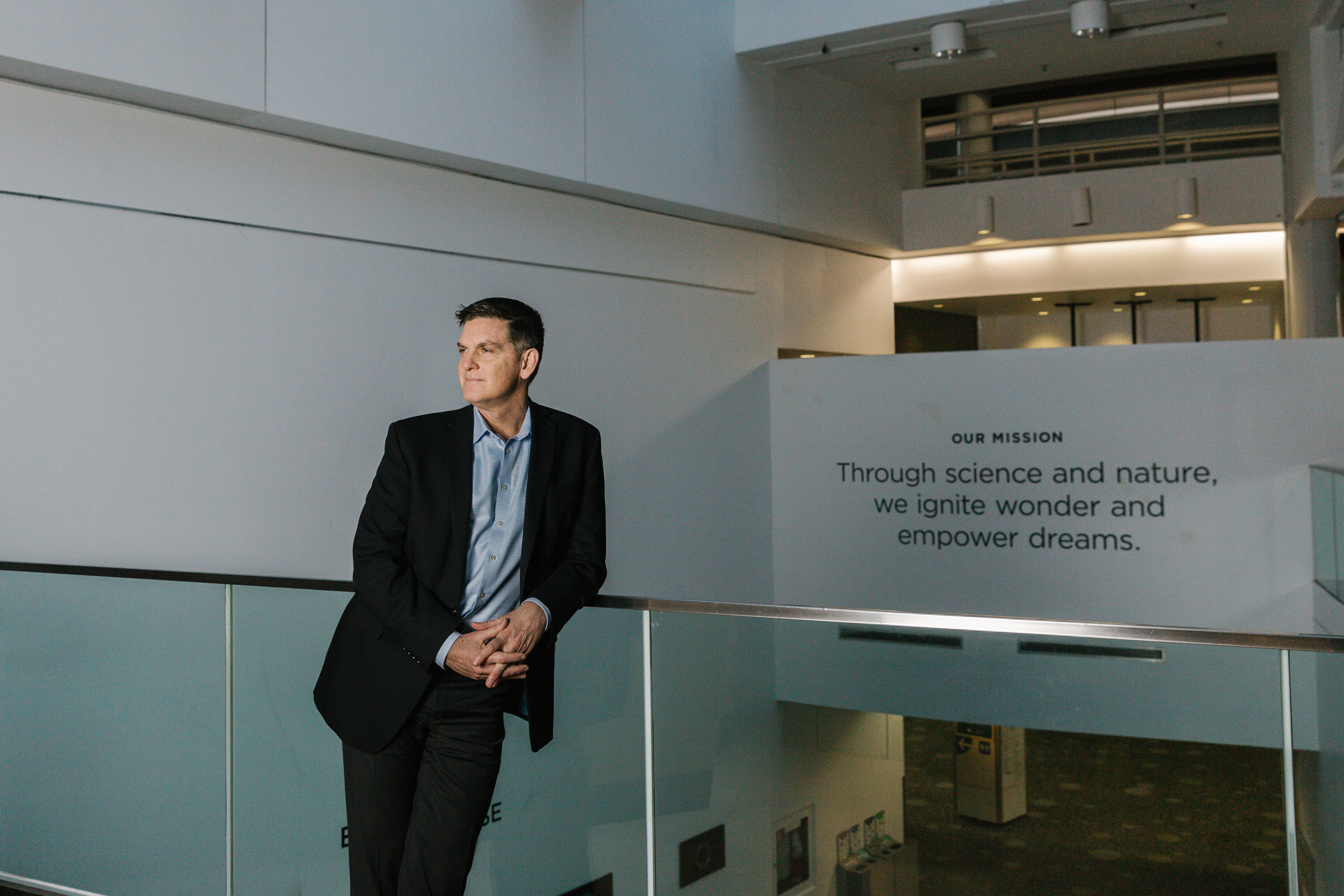Science World’s Dr. Scott Sampson
The man leading Vancouver's beloved science organization into its 30th year—and beyond.

Portrait of Dr. Scott Sampson in front a Allosaurus fragilis
Any paleontologist can discover new dinosaur species. But how many can make them into TV stars?
These days Dr. Scott Sampson is kept busy with his duties as president and CEO of Science World in Vancouver, which is celebrating its 30th birthday this year. But he’s also a dino hunter from way back, part of at least 15 new discoveries at fossil sites around the world. And it’s a lucky species that gets discovered by Sampson. Like the Hollywood legend of the starlet discovered at a soda fountain, mega-lizards uncovered by Sampson’s team often went on to star on the popular PBS show, Dinosaur Train.
That’s because Sampson hosts the animated series, which recently completed production on its fifth season. It features a cast of adventurous young dinosaurs that travel to different eras via “time tunnels” and a magical railway. Produced by the Jim Henson Company, Dinosaur Train airs in over 100 countries. “I get mail daily from Vietnam, Argentina, India,” Sampson says. “It’s been a fun thing I never expected.”
“I’ve spent most of my professional life in natural history museums. They’re all about the past. Science centres are typically about the present. What we’re talking about is becoming future-focused, helping people grasp what a thriving future might look like.”
Digging up Sampson’s own history is simpler—he was born in Vancouver’s Dunbar neighbourhood in 1961 and went to Point Grey Secondary. Education and work took him to Toronto, Utah, and Denver before he returned to Vancouver two and a half years ago to accept the challenge of running Science World. Although his position at the University of Utah offered access to enough bones to satisfy a phalanx of paleontologists, Sampson felt a responsibility to engage with scientific issues in a more immediate way. “I needed to address some of the pressing issues in the world that to my mind have to do with the collision of science, nature, and society,” he says.
Ultimately that led him to Science World and some big plans for the future. “I’m really passionate about institutions like this being vehicles for social change,” he says.
Sampson’s vision for Science World involves expanding beyond childhood education. To put it in Dinosaur Train terms, Sampson would like Science World to travel through the time tunnel, both chronologically and demographically. “I’ve spent most of my professional life in natural history museums. They’re all about the past. Science centres are typically about the present. What we’re talking about is becoming future-focused, helping people grasp what a thriving future might look like.”

Science World on opening day, May 6, 1989 (left) and view of the iconic landmark today (right).
A planned renovation of the False Creek facility will add spaces Sampson hopes will be used in the evenings for public meetings and debates on important issues: “A place where people can come to discuss the pressing issues of our time,” Sampson says. “A safe place for dangerous ideas.”
If time really is like a railroad, Sampson believes there are always different tracks we can take. “There’s a straight line that goes from the Big Bang to this moment. But there’s an infinite number of lines that go from this moment into the future. Some of those lines are thriving futures and some of them are apocalyptic. We want to figure out how to get to these thriving futures. Nobody knows the right answer right now. That’s why we need to bring people together to have these discussions.”
Sampson thinks the institution can play an important role in community discussion. “There’s no reason why this place should be viewed first and foremost as kind of an ‘edu-tainment’ place just for kids. We’re looking to modify that perception.”

But there will still be a focus on youth education, and much of it focuses on promoting careers in science and technology fields. Sampson champions the STEAM acronym. “It stands for ‘Science, Technology, Engineering, Art and design, and Math.’ Eighty per cent of new jobs will require literacy in science, tech, engineering, art and design, and math. And we’re not training for it right now. We’ve taken it on as our role to dramatically scale STEAM literacy across BC.”
Science World has helped to launch a province-wide outreach program called Symbiosis. “It’s about letting kids know the spectrum of things that are out there. Our job is to turn on the lights so they can see the options. [We can] help them find the option that is closest to their passion and abilities, give them mentorship to ultimately get to the career, and then [they can] turn around and help out the next generation.”
In Sampson’s mind, it’s important for all of us to consider our place in time and space. “I’d like people to think about this as their story,” Sampson says. “We don’t think of ourselves as deeply connected to the universe around us. Many people are evolutionists in their heads—they’ll think ‘Yeah, I get it, all mammals come from a single ancestor, and all life on Earth is related.’ But when you go outside and see a dog or a tree or a pigeon, you don’t think about them as your relatives. So part of science communication is getting people to understand in a way that changes the meaning of their lives, to see themselves embedded in this multi-billion year unfinished story that they have a role in.”
He expects his own role will continue to play out at Science World. “I am thrilled and honoured to be able to serve at the helm of this organization,” Sampson says. “It’s a great group of people here.”
“I’m really passionate about institutions like this being vehicles for social change.”
And if being the CEO of Science World isn’t quite as glamorous as TV stardom, that’s all right. Once upon a time, Sampson discovered that celebrity has its downside. It happened back in 2001 when Sampson and his team of paleontologists found a whole new dinosaur species, and decided to name it after Dire Straits rocker Mark Knopfler.
“It’s called Masiakasaurus Knopfleri,” Sampson says. “It was found in Madagascar—Masiakasaurus means ‘vicious,’ so it’s “Vicious Lizard of Knopler.’ We named it after him because whenever we were digging in this particular quarry we would play music, and whenever we played Dire Straits we would find more bones of this new little raptor.”
The reaction was not quite what Sampson expected. “The British tabloids totally attacked me,” he recalls. “They basically said that I named it after Knopfler either because he’s a rock dinosaur, or he’s ugly and buck-toothed, like this dinosaur.”
Happily, the new raptor’s namesake did not feel that way about it. “Knopler took it in the spirit intended and was honoured,” Sampson says. “He sent 15 tickets to his New York City concert and I took the whole crew.”
A fitting tribute from one rock star to another.
_________
Never miss a story. Sign up for NUVO’s weekly newsletter, here.




